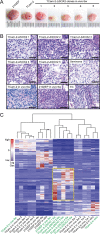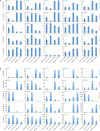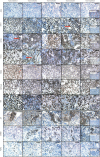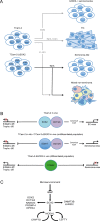SOX2 is essential for in vivo reprogramming of seminoma-like TCam-2 cells to an embryonal carcinoma-like fate
- PMID: 27283990
- PMCID: PMC5216926
- DOI: 10.18632/oncotarget.9903
SOX2 is essential for in vivo reprogramming of seminoma-like TCam-2 cells to an embryonal carcinoma-like fate
Abstract
Type II germ cell cancers (GCC) are divided into seminomas, which are highly similar to primordial germ cells and embryonal carcinomas (EC), often described as malignant counterparts to embryonic stem cells.Previously, we demonstrated that the development of GCCs is a highly plastic process and strongly influenced by the microenvironment. While orthotopic transplantation into the testis promotes seminomatous growth of the seminoma-like cell line TCam-2, ectopic xenotransplantation into the flank initiates reprogramming into an EC-like fate.During this reprogramming, BMP signaling is inhibited, leading to induction of NODAL signaling, upregulation of pluripotency factors and downregulation of seminoma markers, like SOX17. The pluripotency factor and EC-marker SOX2 is strongly induced.Here, we adressed the molecular role of SOX2 in this reprogramming. Using CRISPR/Cas9-mediated genome-editing, we established SOX2-deficient TCam-2 cells. Xenografting of SOX2-deficient cells into the flank of nude mice resulted in maintenance of a seminoma-like fate, indicated by the histology and expression of OCT3/4, SOX17, TFAP2C, PRDM1 and PRAME. In SOX2-deficient cells, BMP signaling is inhibited, but NODAL signaling is not activated. Thus, SOX2 appears to be downstream of BMP signaling but upstream of NODAL activation. So, SOX2 is an essential factor in acquiring an EC-like cell fate from seminomas.A small population of differentiated cells was identified resembling a mixed non-seminoma. Analyses of these cells revealed downregulation of the pluripotency and seminoma markers OCT3/4, SOX17, PRDM1 and TFAP2C. In contrast, the pioneer factor FOXA2 and its target genes were upregulated, suggesting that FOXA2 might play an important role in induction of non-seminomatous differentiation.
Keywords: SOX2/SOX17; TCam-2; embryonal carcinoma; reprogramming; seminoma.
Conflict of interest statement
The authors declare no conflicts of interest.
Figures






Similar articles
-
Unique and redundant roles of SOX2 and SOX17 in regulating the germ cell tumor fate.Int J Cancer. 2020 Mar 15;146(6):1592-1605. doi: 10.1002/ijc.32714. Epub 2019 Nov 1. Int J Cancer. 2020. PMID: 31583686
-
BMP Inhibition in Seminomas Initiates Acquisition of Pluripotency via NODAL Signaling Resulting in Reprogramming to an Embryonal Carcinoma.PLoS Genet. 2015 Jul 30;11(7):e1005415. doi: 10.1371/journal.pgen.1005415. eCollection 2015 Jul. PLoS Genet. 2015. PMID: 26226633 Free PMC article.
-
TCam-2 Cells Deficient for SOX2 and FOXA2 Are Blocked in Differentiation and Maintain a Seminoma-Like Cell Fate In Vivo.Cancers (Basel). 2019 May 25;11(5):728. doi: 10.3390/cancers11050728. Cancers (Basel). 2019. PMID: 31130628 Free PMC article.
-
The plasticity of germ cell cancers and its dependence on the cellular microenvironment.J Cell Mol Med. 2017 Aug;21(8):1463-1467. doi: 10.1111/jcmm.13082. Epub 2017 Feb 28. J Cell Mol Med. 2017. PMID: 28244655 Free PMC article. Review.
-
Human testicular (non)seminomatous germ cell tumours: the clinical implications of recent pathobiological insights.J Pathol. 2009 Jun;218(2):146-62. doi: 10.1002/path.2522. J Pathol. 2009. PMID: 19253916 Review.
Cited by
-
Molecular and epigenetic pathogenesis of germ cell tumors.Asian J Urol. 2021 Apr;8(2):144-154. doi: 10.1016/j.ajur.2020.05.009. Epub 2020 May 30. Asian J Urol. 2021. PMID: 33996469 Free PMC article. Review.
-
The MicroRNA-371 Family as Plasma Biomarkers for Monitoring Undifferentiated and Potentially Malignant Human Pluripotent Stem Cells in Teratoma Assays.Stem Cell Reports. 2018 Dec 11;11(6):1493-1505. doi: 10.1016/j.stemcr.2018.11.002. Epub 2018 Nov 29. Stem Cell Reports. 2018. PMID: 30503260 Free PMC article.
-
Therapeutical interference with the epigenetic landscape of germ cell tumors: a comparative drug study and new mechanistical insights.Clin Epigenetics. 2022 Jan 7;14(1):5. doi: 10.1186/s13148-021-01223-1. Clin Epigenetics. 2022. PMID: 34996497 Free PMC article.
-
Activin and BMP Signalling in Human Testicular Cancer Cell Lines, and a Role for the Nucleocytoplasmic Transport Protein Importin-5 in Their Crosstalk.Cells. 2023 Mar 24;12(7):1000. doi: 10.3390/cells12071000. Cells. 2023. PMID: 37048077 Free PMC article.
-
CDK4/6 inhibition presents as a therapeutic option for paediatric and adult germ cell tumours and induces cell cycle arrest and apoptosis via canonical and non-canonical mechanisms.Br J Cancer. 2020 Aug;123(3):378-391. doi: 10.1038/s41416-020-0891-x. Epub 2020 May 18. Br J Cancer. 2020. PMID: 32418994 Free PMC article.
References
-
- Oosterhuis JW, Looijenga LHJ. Testicular germ-cell tumours in a broader perspective. Nat Rev Cancer. 2005;5:210–22. - PubMed
-
- Kristensen DG, Skakkebk NE, Rajpert-de-Meyts E, Almstrup K. Epigenetic features of testicular germ cell tumours in relation to epigenetic characteristics of foetal germ cells. Int J Dev Biol. 2013;57:309–17. - PubMed
-
- de Jong J, Stoop H, Gillis A, van Gurp R, van de Geijn G-J, de Boer M, Hersmus R, Saunders P, Anderson RA, Oosterhuis JW, Looijenga L. Differential expression of SOX17 and SOX2 in germ cells and stem cells has biological and clinical implications. J Pathol. 2008;215:21–30. - PubMed
-
- Gillis AJM, Stoop H, Biermann K, van Gurp RJHLM, Swartzman E, Cribbes S, Ferlinz A, Shannon M, Oosterhuis JW, Looijenga LHJ. Expression and interdependencies of pluripotency factors LIN28, OCT3/4, NANOG and SOX2 in human testicular germ cells and tumours of the testis. International Journal of Andrology. 2011;34:e160–74. - PubMed
MeSH terms
Substances
LinkOut - more resources
Full Text Sources
Other Literature Sources
Molecular Biology Databases

